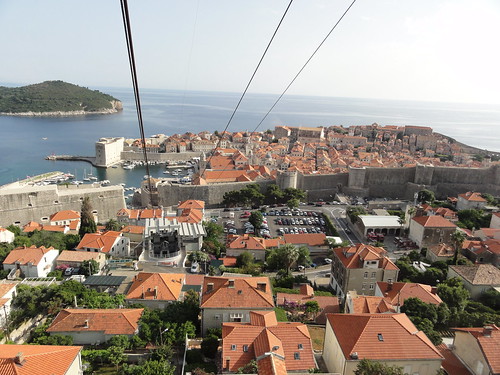It’s generally accepted that Urban Gondolas and Cable Cars don’t exist in high-density, residential areas. Generally, that is.
That’s likely the reason people have such an adverse reaction when proposals bubble up to the surface for systems flying over residential areas. Look at Portland or Burnaby, for example. How Urban Gondolas and Cable Cars interact with urban form and fabric should therefore be of the utmost concern when planning a line.
At the same time, we’re also beginning to discover more and more systems that – while touristic in nature – interact with the urban form in such a way that they appear to be less detrimental to residential areas that we originally thought (the Bolzano 3S or Pilatusbahn, for example).
Along that line of thinking comes a link from Bob . . .
Bob points us in the direction of the Dubrovnik Cable Car in Croatia. This modest and newly refurbished Aerial Tram opened just last year. It’s only 778 meters in length and can only transport 470 pphpd, but the way it engages with the surrounding urban environment suggests systems like this may be more acceptable in the future.
If nothing else, notice the use of orange in the cabins that reflect and remind one of the orange clay roofs so characteristic of Dubrovnik. Sometimes small, subtle touches like this make all the difference in the world.
It would be fascinating to know the planning process that underpinned this system. How was it originally proposed? Were people against it? Were they for it? What was the impact on surrounding property values? All these would be valuable questions to answer. So if any readers out there have any answers, we’d love to hear them in the comments.
In the meantime, take a look:
Just a quick note: Thanks so much to Bob for the link! More and more we’re relying on the collective intelligence and resourcefulness of our community to spot interesting developments and projects that have a direct impact on the urban environment. So like Bob and the others that came before him, if you know of a Cable Propelled Transit system we should look at, please send us an email or a link at gondola (at) creative urbanprojects (dot) com. We can’t do this all by ourselves, after all.


2 Comments
I love Dubrovnik. The cable car must have been out of service when I visited – I remember hiking up to the fortress on top of the mountain.
One thing to note about old Dubrovnik (the part inside the walls) – I consider it an ideal model for the urban form. Even with just 5 story buildings, there is enough density to run a neighborhood well. Very narrow streets, very narrow storefronts, and mixed use everywhere means an amazing walkable community. And the central square is a meeting place for the city – I was there during a world cup game, and it was projected on a building with hundreds of neighbors all seated in the square, watching together (and cheering, jeering, laughing, drinking and eating together). Ok, it’s a tourist spot and therefore far from proof that such a community can exist without external support. But if I could find a city like this that’s not just for tourists I’d move there in a minute.
Since the system was refurbished the “planning process” was likely not a large concern. It seems the system, originally built in 1969, had been out of commission since the bombings in 1991.
[img]http://croatiatraveller.com/blog/wp-content/uploads/2010/02/cable-car-dubrovnik1.jpg[/img] link
Before it was destroyed the cable car was very popular. (There was a disco at the top in the 1980s!)
Probably opening the new system was seen much more as a sign of growth and recovery than of a problem or imposition. It probably followed the same, well-established route. This would likely have mitigated most of the concerns about putting a touristy cable system in a dense urban environment, since the city had already been developing around the original cable car for over two decades.